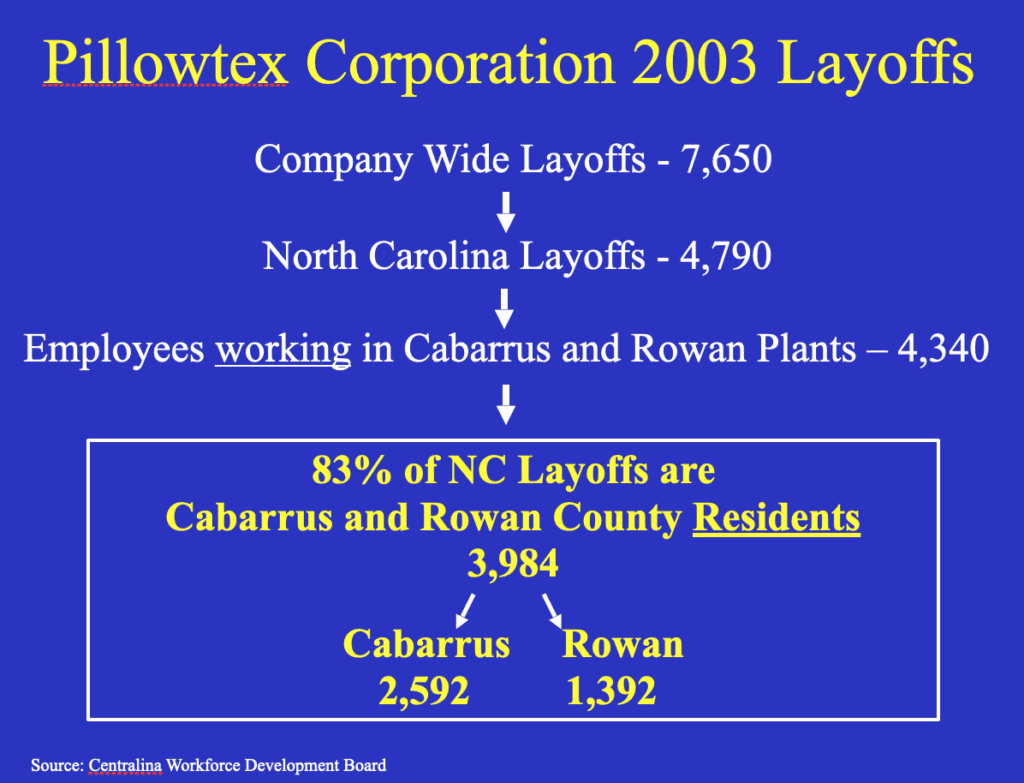

Share this story
- It is clear that the Pillowtex closure left a mark on Kannapolis — one we can expect to see in Canton — but it also provided a unique opportunity to offer skilled training to the local workforce and innovate the local economy.
- The closure of the Canton mill is a tragedy for North Carolina, but it is not the first of its kind. The 2003 Pillowtex Corp. closure in Kannapolis offers insight into the challenges and unique opportunities ahead.
|
|
Highlights
- In March, Pactiv Evergreen announced the imminent closure of the paper mill in Canton, North Carolina. The 2003 closure of Pillowtex Corp. in Kannapolis laid the groundwork for local and state response strategies to mass layoffs.
- By quickly mobilizing response strategies through interagency collaboration, Pillowtex employees had access to essential human services before their last days on the job.
- Collecting key demographic data from former Pillowtex employees through state-sponsored surveys helped anticipate roadblocks to reemployment.
- Including former Pillowtex administrative officials in the coordination of response strategies provided key insight into the needs of former employees.
- By continuing to reflect on the progress made and the road ahead in the years following the Pillowtex shutdown, the strategic plan was iterative and flexible.
- The Pillowtex closure provided a unique opportunity to offer skilled training to the local workforce and innovate the local economy.
The March 6 announcement of the imminent closure of the paper mill in Canton, North Carolina, owned by Pactiv Evergreen, sent shock waves through the local community and the state at large. The Canton mill has been in operation for over a century in Haywood County and has sustained generations of local mill workers.
The mill’s closure will leave many North Carolinians unemployed and fearful for their future. The state is preparing response strategies to serve community members before the mill’s last days in June, looking to the past to inform next steps in the present.
The state’s history of mill closures
The closure of the Canton mill is a tragedy for North Carolina, but it is not the first of its kind.
The 2003 bankruptcy of Pillowtex Corp., based in Kannapolis, resulted in the single largest mass layoff in the state’s history. About 4,800 North Carolina workers lost their jobs following the Cannon Mills closure, and another 430 employees were laid off as a direct result. Most of these workers were concentrated in Cabarrus and Rowan counties. Communities founded on the mill’s production of household textile products were suddenly left purposeless.


A stark difference between the closure of the Cannon and Canton mills is the shock factor that was induced by each announcement. Pillowtex Corp. had been spiraling long before the July 30, 2003 announcement of the company’s cessation of operations, and employees had been worried for the mill’s longevity since the company’s first bankruptcy filing in November of 2000.
The anticipation of the mill’s closure allowed state and local response tactics to be developed in advance of mass layoffs. By April of 2003, Pillowtex was already coordinating with state agencies about necessary resources for employees pending layoffs, and by May they had done the same with federal agencies.
Cabarrus County officials followed suit, establishing the Community Service Center (CSC), which operated out of a local church, a week after the announced layoffs. The center neighbored the textile mill and offered essential human services to Pillowtex employees through the coordinated efforts of more than a dozen local community organizations and agencies. Services ranged from basic needs to debt management, foreclosure avoidance, housing, and more. The CSC became a one-stop shop for Pillowtex employees to access the resources they needed in a comfortable and supportive community setting.
Unlike the many years that signaled turmoil for Pillowtex ahead of the company’s closure, the closure of the Canton mill has come as a shock to employees and the community at large. As a result, the local community has only the time between now and June to coordinate response strategies and to offer necessary resources to those directly impacted.
A deeper understanding of the announcement of the Pillowtex closure and what followed is crucial to ensuring efficient and effective local and state response strategies are developed for the Canton mill closure.
How the Pillowtex closure can inform the now


The unprecedented nature of the closing of Cannon Mills sparked ample research on the topic, resulting in independent reports on community response strategies, state-sponsored surveys of employees, county-commissioned assessments, and even congressional testimonies. These and other resources have been compiled by EdNC for your convenience.
Community response strategies
Below is a 2004 report that details the history of Pillowtex, the build up to the company’s closure, and the primary response tactics that ensued to tackle the array of community struggles that arose.
The report outlines the services offered by the Community Service Center and its funding sources, the Pillowtex employees’ union, the Union of Needletrades, Industrial and Textile Employees (UNITE), the North Carolina Rapid Response Team, national emergency grants, and the local community college, Rowan-Cabarrus Community College.
The report also highlights the major struggles these organizations faced in their efforts to support the local community, which included the loss of local tax revenue, the high number of non-skilled workers that were laid off, and the sudden lack of health insurance for former employees, to name a few.
Because many of the community response strategies noted in the report were still in progress at the time of the report’s release, it does not offer a full picture of how the community eventually overcame these challenges.


Unique worker demographics
Following the announcement of the mill closure, surveys were conducted of Pillowtex employees in Cabarrus and Rowan counties to inform the aforementioned response strategies. Below are some of the data points on workers that were gathered:
- 40-50% had not completed high school
- The average age was 46
- The average tenure was 17 years, with a median of 13.5 years
- The employee makeup was 59% female, 41% male
- Approximately 500 employees, predominantly Hispanic, did not speak English
- Weekly wages ranged from $220 to $1140, averaging $458
- Unemployment benefits ranged from $73 to $408, averaging $275 weekly
- The difference between unemployment insurance benefits and prior wages was $178 weekly
- 42% had a relative who also worked at Pillowtex
- 73% were interested in community college offerings
- 30% were willing to consider relocation; 70% were unwilling
- Average indebtedness, excluding mortgages, ranged by age groups from $1,900 to $9,070
- By the first week of August, 43% reported being behind in rent or mortgage payments with over 10% receiving eviction/foreclosure notices
- 93% indicated they couldn’t afford or get health insurance
- 73% were concerned about getting prescriptions, the average cost of which was $209
The survey revealed that employees were on average older, non-skilled workers, many of whom were non-English speakers. These demographics complicated the ease with which workers could find new employment without targeted assistance from local and state agencies.
Collecting similar information from employees of the Canton mill could inform next steps by helping identify and preempt the major challenges that will arise upon the mill’s closure.
An iterative process
A year after the mill’s closure, leaders in Cabarrus County gathered for a presentation to reflect on the impact the Pillowtex Corp.’s closure had on the community. Below is a copy of the presentation.
The following slide measures the progress that had been made in August of 2004 toward supporting, educating, and hiring the many North Carolinians that lost their jobs a year prior.


During the presentation, Ed Hosack, former division general manager of Cannon Mills, said, “The response by our community has been tremendous … which I believe is a testimony to the strength of our families, our churches, and our community. Our local foundations, as well as state and federal agencies, have responded to meeting the basic needs of our unemployed neighbors – a level of need that still proves to be overwhelming.”
Having key administration from Pillowtex Corp. like Hosack inform the moving forward allowed response strategies to be tailored to the specific needs of the company and its former employees.
Importantly, the presentation also highlighted the challenges that were still being faced by the community, and the plans that were in place to forge ahead. It is clear that finding resolution for community members in Kannapolis was an iterative process informed by many.
In December 2004, the Cabarrus Community Planning Council released the following annual report, which was informed by telephone surveys of community members and used to identify “community assets and strengths as well as unmet needs.”
You can find the specific questions that were asked in the telephone survey under Appendix B on pages 71-80 of the document.
Given the closure of the mill in the previous year, there was a swell of unmet needs in Cabarrus County that were either directly or indirectly associated with Pillowtex Corp.’s bankruptcy.


“With the closing of Pillowtex, the August 2003 unemployment rate in Cabarrus County rose to 10.9% compared to the August 2002 rate of 5.3%,” the report states.
Many of the community assets cited in the report are services that arose to manage the mass layoffs from the year prior.
Community residents say that, ‘if Pillowtex had a silver lining’, it was the way the agencies, organizations and healthcare providers came together to help meet the needs of these families. Though the immediate crisis has somewhat abated, the needs of many of the workers and their families are still not completely resolved. Further, community leaders and human services organizations believe that the effects of the closing will be felt for many years to come.
Cabarrus County 2004 Community Assessment
The strength and resilience of community members in the face of strife was itself an asset, as residents quickly pushed to meet new standards of economic development in a time of rapid change.
Residents see the recent closings at Corning and Pillowtex as a “wake up call” for new economic development in the county. They voiced the need for public and private entities to seek creative ways to bring new jobs to the community and to provide infrastructure improvements to support new industries.
Cabarrus County 2004 Community Assessment


Long-term positive effects
In 2008, five years after the announcement of the closure of Cannon Mills, Jeanie Moore, the then-vice president of continuing education at Rowan-Cabarrus Community College, testified before Congress. She reflected on the challenges the community college faced in meeting increased demand, as well as the college’s outcomes and lessons learned since the mill’s closure.
You can find a transcript of Moore’s testimony below.
The community college mobilized to meet the needs and interests of former Pillowtex employees through the creation of new courses and certification programs.
“Community college programs such as welding technology, electrical/electronics and air conditioning, heating and refrigeration experienced enrollment increases of 40 to 400 percent following the Pillowtex closure,” notes a 2006 report by the North Carolina Rural Development Center.
A major challenge was that despite increased enrollment, additional funding for the college was not granted until a year after the initial enrollment spike. A similar struggle may be on the horizon for Canton’s local community college, Haywood Community College.
On the other hand, Moore told EdNC that one of the greatest positive effects of the Cannon Mills closure was the newfound appreciation the local community had for the community college.
“I think it really changed a lot of people’s idea of what the community college was all about,” she said. “We still get accolades from people in the community for what was done. … We were really a big part of that catalyst for change.”
In her testimony, Moore also reflected on the progress the community as a whole had made since 2003. She shared that with the closure of Cannon Mills came the development of the North Carolina Research Campus (NCRC), which “is a scientific community that collaboratively works to empower human health through nutrition” that expects to create over 37,450 jobs in the community by 2032. NCRC exemplifies how Kannapolis was able to turn the Cannon Mills closure into an opportunity to bridge local workers to jobs of the future.
By 2005, 2,730 former Pillowtex employees were reemployed, and more than half (57%) had found jobs outside of the volatile manufacturing industry. Instead, workers sought more stable positions in industries of the future.
It is clear that the Pillowtex closure left a mark on Kannapolis — one we can expect to see in Canton — but it also provided a unique opportunity to offer skilled training to the local workforce and innovate the local economy.
In compiling the resources for this article, EdNC attempted to locate a 2003 survey of Pillowtex Corp. employees that was commissioned by the North Carolina Department of Commerce Division of Employment and Training. We were unable to locate the survey through the Department of Commerce’s office or in the state archives.
If you have any suggestions for where we could find the survey, please contact aquattrocchi@ednc.org.






